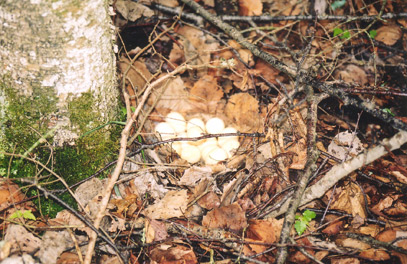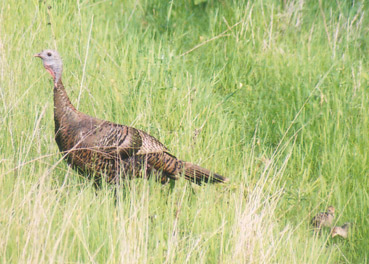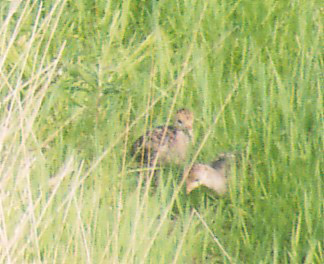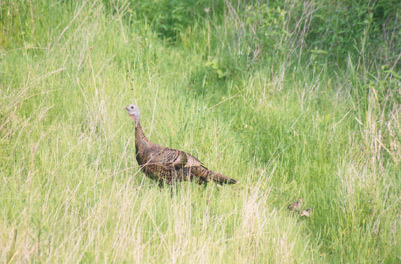OUT OF THE FRYING PAN, INTO THE FIRE…Successful hatch low, predation high for upland birds
By Dick Ellis
The ground nest lies somewhere just ahead in the Vilas County peninsula of pine and birch bordering the stump-laden backwater of the Manitowish chain. Rich Waters stopped again and strained into the underbrush, challenging nature’s camouflage with the human eye in an attempt to reveal the ruffed grouse he had stumbled upon a week earlier.
If the Boulder Junction resident could find her before she “caught” him, I might get a unique shot with the telephoto lens. Waters, though, had not revisited the nest because cold, rainy northern Wisconsin weather was already enough of a challenge for the hen without her having to abandon the eggs too often, even temporarily. Remembering just where she was would now be the challenge of the day.
 |
| Lucky 13? This ruffed grouse ground nest of 13 eggs was photographed in Vilas County on June 15. The hen feigned injury and attempted to lead the reporter away from the nest upon his approach. Despite cold, rainy weather and constant predation threats a revisit to the nest revealed that the eggs apparently hatched successfully sometime that week |
The hen’s noisy departure from the nest brought our focus squarely on her, as she intended, and told us immediately that mother in the maternity ward is still on her toes for trouble. The grouse tumbled out of the nest, and with her “broken” wing keeping her grounded and running, begged us to follow her away from the clutch of 13 eggs.
Although her action may be purely instinct-driven, there’s nothing quite as courageous as a mother protecting her young. It can be as tenacious as a sow bringing down all her wrath on a boar that would just as soon eliminate the competition while the cubs are still too small to negotiate a tree. To an upland game bird feigning injury to divert the attention of a potential predator from her precious secret of ground-nested eggs.
Survival of the species is priority one for mother. For upland birds including turkeys, pheasants, and ruffed grouse, the most crucial time determining success or failure is right now. How successful will mother be in keeping her eggs warm and dry in the face of unpredictable weather? And then how successful in keeping herself and her chicks or poults safe from predators? The answers determine fall forecasts and population numbers.
According to Wildlife Ecologist Keith Warnke of the Department of Natural Resources (DNR), upland game hens have a difficult row to hoe from day one. For example, 93 percent of hen turkeys, which generally have more success nesting than ruffed grouse and pheasants, attempt to nest at the beginning of the nesting season. Only 22 percent are actually successful in pulling off a hatch.
That dismal success rate becomes even more telling when one realizes that 90 to 95 percent of the eggs are fertile when first dropped in the nest. Successful nesting is a difficult proposition, despite mother’s devotion to the task at hand.
“The weather and predators really do a number on the eggs, the chicks and poults, and the hens too,” Warnke said. “Hens are most vulnerable right now to predation during the nesting season. Even as adults they’re basically just food for every predator out there. And their young are just tasty little morsels.”
Ruffed grouse hatch earlier than their upland cousins, Warnke said. With a 24-day incubation period and June hatch, most clutches have already hatched by this June 18 interview. Clutch size will vary between six and 16 eggs. Turkeys, he said, have a 28-day incubation period with a peak hatch on June 20th but ranging from June 15 to June 25. An average clutch size is 11 eggs. Pheasant have a 23 to 24 day incubation period, drop seven to 16 eggs with an average clutch of 12, and experience peak hatch June 18.
“So right now it’s critical for upland game birds to stay as dry as possible,” Warnke said. “Cold and rain can really play havoc on the new chicks and cause trouble for the game birds. The key is to stay warm and dry in May and June.”
Generally, he said, the earlier upland game hens nest, the more successful, the higher the clutch numbers, the higher the clutch survival post-hatch and ultimately, the higher contribution to fall population numbers. Later hatches or re-nest production after a first failed nest means lower brood numbers, and young chicks more prone to predation. Predators are done birthing their own young later and on the prowl to rear those young. Smaller, younger upland game chicks become more vulnerable to those predators, and an easy source of food.
“The older the better for upland game chicks finding and competing for food,” Warnke said. “The older the better to survive the predators. It’s like the old joke where two men are running from a grizzly bear and one stops to put on tennis shoes. `What are you doing?’ the other man asks. ‘It’s no use. We’ll never outrun a bear.’ `I don’t have to outrun the bear,’ the first man answers.”
In northern Wisconsin, Waters and I backed off quickly on mother grouse June 15 following a few photos of her nest. A revisit this week showed evidence that the hen’s efforts had apparently been successful.
Between those visits, the telephoto lens worked in southern Wisconsin as a hen turkey slowly and diligently led five newborn poults on a seemingly perilous journey for survival through a grassland jungle. On my own journey home, the increasingly familiar flash of movement in a field less than a mile from the turkeys brought the truck to a stop. The coyote eventually disappearing into a distant woodlot seemed equally diligent and determined on some endless and urgent journey dictated by nature.
 |
 |
 |
|
| This hen turkey out with a not-so-relaxed stroll with her five newborn chicks last week in Waukesha County showed extreme caution for danger. Two of the chicks are visible about two feet from mother’s tail feathers. Despite turkeys having the highest nest hatch rate of Wisconsin’s upland game birds, only about 22 percent of the nests successfully hatch. | |
Whether the paths of predator and prey intersect will be a roll of the dice. But two things are certain. When mother hen north or south hatches her eggs, she already beats significant odds. And her job is just beginning.
“There’s very high predation while she’s on the nest, and after the hatch,” Warnke said. “They’re very exposed. It’s a risky life.”
MAN PART OF PREDATOR FORCE
In Wisconsin, man becomes part of the predation force targeting upland game, although not until September for grouse, and October for turkeys and pheasants. Those of us who hunt the ruffed grouse almost without exception head to the northern forests. Those of us who hunt the wild pheasant predominantly head to the open agriculture lands and conservation reserve program habitat of southern Wisconsin, with excellent pockets also found in the northwest.
And with a turkey population that has exploded from 335 birds in 1976 to more hundreds of thousands, with an ever-expanding territory, turkey hunters need to travel less and less to find success. Regardless of your county of residence, a quality turkey hunt isn’t far away.
MOURNING DOVES…Multiple clutches, high mortality
Mourning doves, unlike their upland cousins, rely on multiple annual clutches and high numbers to sustain the species, according to DNR Wildlife Ecologist Keith Warnke. “Mourning doves have between two and five clutches of eggs,” he said. “They really produce a lot of numbers. They’re unsuccessful in nesting but extremely successful as a species. What they do, breeding early and often, works.”
Mourning doves, unlike their upland cousins, rely on multiple annual clutches and high numbers to sustain the species, according to DNR Wildlife Ecologist Keith Warnke. “Mourning doves have between two and five clutches of eggs,” he said. “They really produce a lot of numbers. They’re unsuccessful in nesting but extremely successful as a species. What they do, breeding early and often, works.”
This hen turkey out with a not-so-relaxed stroll with her five newborn chicks last week in Waukesha County showed extreme caution for danger. Two of the chicks are visible about two feet from mother’s tail feathers. Despite turkeys having the highest nest hatch rate of Wisconsin’s upland game birds, only about 22 percent of the nests successfully hatch.







